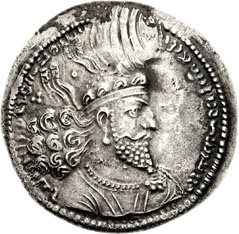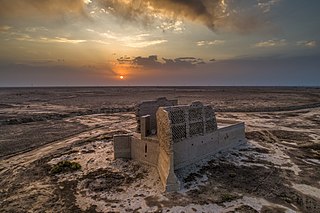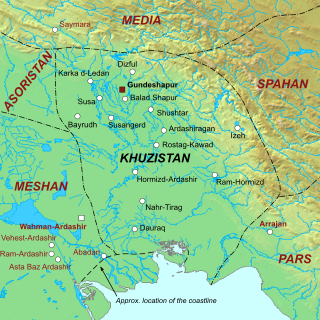
Hormizd-Ardashir, better known by his dynastic name of Hormizd I, was the third Sasanian King of Kings (shahanshah) of Iran, who ruled from May 270 to June 271. He was the third-born son of Shapur I, under whom he was governor-king of Armenia, and also took part in his father's wars against the Roman Empire. Hormizd I's brief time as ruler of Iran was largely uneventful. He built the city of Hormizd-Ardashir, which remains a major city today in Iran. He promoted the Zoroastrian priest Kartir to the rank of chief priest (mowbed) and gave the Manichaean prophet Mani permission to continue his preaching.

Hormizd II was king (shah) of the Sasanian Empire. He ruled for seven years and five months, from 303 to 309. He was a son and successor of Narseh.

Hormizd III, was the seventeenth king (shah) of the Sasanian Empire, ruling briefly from 457 to 459. He was the son and successor of Yazdegerd II. His reign was marked by the rebellion of his younger brother Peroz I, who with the aid of one of the Seven Great Houses of Iran, the House of Mihran, and the eastern neighbours of the Sasanians, the Hephthalites, had him captured and executed.

Bahram I was the fourth Sasanian King of Kings of Iran from 271 to 274. He was the eldest son of Shapur I and succeeded his brother Hormizd I, who had reigned for a year.

Bahram II was the fifth Sasanian King of Kings (shahanshah) of Iran, from 274 to 293. He was the son and successor of Bahram I. Bahram II, while still in his teens, ascended the throne with the aid of the powerful Zoroastrian priest Kartir, just like his father had done.

Bahram III, was the sixth king (shah) of the Sasanian Empire. He was son and successor of Bahram II. As a prelude to his kingship he was viceroy in the province of Sakastan, which had been re-conquered by his father sometime in the 280s.

Shapur I was the second Sasanian King of Kings of Iran. The dating of his reign is disputed, but it is generally agreed that he ruled from 240 to 270, with his father Ardashir I as co-regent until the death of the latter in 242. During his co-regency, he helped his father with the conquest and destruction of the Arab city of Hatra, whose fall was facilitated, according to Islamic tradition, by the actions of his future wife al-Nadirah. Shapur also consolidated and expanded the empire of Ardashir I, waged war against the Roman Empire, and seized its cities of Nisibis and Carrhae while he was advancing as far as Roman Syria. Although he was defeated at the Battle of Resaena in 243 by Roman emperor Gordian III, he was the following year able to win the Battle of Misiche and force the new Roman Emperor Philip the Arab to sign a favorable peace treaty that was regarded by the Romans as "a most shameful treaty".

Narseh was the seventh Sasanian King of Kings of Iran from 293 to 303.

Bānbishn was a Middle Persian title meaning "queen", and was held by royal women in Sasanian Iran who were the king's daughters and sisters, and also by the consorts of the Sasanian princes that ruled parts of the country as governors. The full version of the title was bānbishnān bānbishn.

Bahrām Chōbīn or Wahrām Chōbēn, also known by his epithet Mehrbandak, was a nobleman, general, and political leader of the late Sasanian Empire and briefly its ruler as Bahram VI.

Sakastan was a Sasanian province in Late Antiquity, that lay within the kust of Nemroz. The province bordered Kirman in the west, Spahan in the north west, Kushanshahr in the north east, and Turan in the south east. The governor of the province held the title of marzban. The governor also held the title of "Sakanshah" until the title was abolished in ca. 459/60.

Sistān, known in ancient times as Sakastān, is a historical and geographical region in present-day Eastern Iran and Southern Afghanistan. Largely desert, the region is bisected by the Helmand River, the largest river in Afghanistan, which empties into the Hamun Lake that forms part of the border between the two countries.

Vistahm or Bistam, was a Parthian dynast of the Ispahbudhan house, and maternal uncle of the Sasanian king of kings of Iran, Khosrow II. Vistahm helped Khosrow regain his throne after the rebellion of another Parthian noble Bahram Chobin, of House of Mihran, but later led a revolt himself, and ruled independently over a region which encompassed the entire Iranian East until he was defeated by Khosrow and his allies.

Farrukh Hormizd or Farrokh Hormizd, also known as Hormizd V, was an Iranian prince, who was one of the leading figures in Sasanian Iran in the early 7th-century. He served as the military commander (spahbed) of northern Iran. He later came in conflict with the Iranian nobility, "dividing the resources of the country". He was later killed by Siyavakhsh in a palace plot on the orders of Azarmidokht after he proposed to her in an attempt to usurp the Sasanian throne. He had two children, Rostam Farrokhzad and Farrukhzad.

Shapurdukhtak was a 3rd-century Sasanian queen (banbishn). She was the wife of her cousin, king Bahram II.
Shapur Meshanshah, was a 3rd-century Sasanian prince. He was the second son of the Sassanian shah Shapur I, and was married to a certain queen named Denag, who bore him several children named Hormizd, Hormizdag, Odabakht, Bahram, Shapur, Peroz, and Shapurdukhtak. Shapur was during an unknown date appointed as the governor of Meshan by his father, and sometime later he gave his wife the honorific title of Dastgerd-Shapur. He died in 260, and was probably succeeded by his wife as the governor of Meshan.
Odabakht was a 3rd-century Sasanian prince. He was the son of Shapur Mishanshah, a Sasanian prince who governed Maishan, and was the son of the Sassanian shah Shapur I. Odabakht's mother was a certain queen named Denag. Odabakht had many other siblings named Hormizdag, Hormizd, Bahram, Shapur, Peroz, and Shapurdukhtak. In 260, his father died and was probably succeeded by Denag as the governor of Maishan.

Hormizd I Kushanshah was Kushanshah of the Kushano-Sasanian Kingdom from 275 to 300. His reign was marked by his rebellion against his brother and suzerain the Sasanian King of Kings Bahram II.

Khuzistan or Huzistan was a Sasanian province in Late Antiquity, which almost corresponded to the present-day province of Khuzestan. Its capital was Gundeshapur. During the late Sasanian era, the province was included in the southern quadrant (kust) of Nemroz.